Kandy washing machine does not drain water
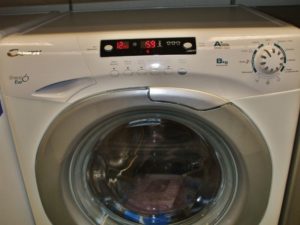 It is easy to guess that the Candy washing machine does not drain water. The system will unsuccessfully start the pump, hum, and after a couple of attempts it will go silent, cancel the program, display an error and be left with a full drum. It will not be possible to ignore such a stop - the laundry in the soapy solution will remain in the locked hatch. In any case, you will have to solve the problem - troubleshoot and repair it.
It is easy to guess that the Candy washing machine does not drain water. The system will unsuccessfully start the pump, hum, and after a couple of attempts it will go silent, cancel the program, display an error and be left with a full drum. It will not be possible to ignore such a stop - the laundry in the soapy solution will remain in the locked hatch. In any case, you will have to solve the problem - troubleshoot and repair it.
Don't neglect to inspect the filter
It will not be possible to immediately determine the reasons for a non-functioning drain. A comprehensive diagnosis is required, including analysis of the washing machine’s behavior and checking of drainage “sore spots.” It is important to remember at what stage the system froze, whether the pump managed to pump out at least part of the water, and how the machine hummed before the pump stopped.
More often than not, one of the following drainage elements is to blame for drainage problems on Candy: a garbage filter or the pump itself. The first one gets clogged, the second one is blocked by hair or fails. In any case, the diagnosis of the machine begins with the “trash bin”. You can get to it like this:
- disconnect the machine from the power supply, turn off the water supply;
- move the washing machine away from the wall;
When draining water through the garbage filter from the machine, it is better to remove all moisture-absorbing products, coatings and detergents.
- prepare the area for drainage: remove powders and rugs, cover with oilcloth and rags;

- find a container to collect water (you will need a basin the size of the drum);
- unhook the technical hatch door, which is located at the bottom right, from the body;
- lean the washing machine against the wall, lifting it 4-8 cm;
- Place the prepared container under the filter - a black “washer”.
Next, all that remains is to grab the protruding part of the lid and carefully twist it clockwise. It is better to move slowly so that the stream of flowing water does not have a strong pressure. As soon as the flow stops and the “spiral” weakens, you can remove the “trash can” from its seat. It is almost impossible to avoid a small “flood”; be prepared for dirt and soap.
Then we start cleaning the filter. Using an old toothbrush and soap, remove all adhered debris, tangled hair and other dirt from the plastic. Then thoroughly rinse the nozzle under the tap. If the “cleaning” carried out is not enough, and a thick layer of scale or stubborn dirt remains on the spiral, then you need to soak the part in a warm lemon solution. The duration of soaking depends on the condition of the “trash bin” - on average, 4-5 hours are enough. The part cannot be placed in boiling water, since in water above 60-90 degrees the material is deformed.
You'll have to remove the pump
If the “trash can” is clean, then the problem of the failed drainage is something else – a broken pump. It is the pump that is “responsible” for emptying the tank, and if it breaks down, pumping out water becomes impossible. To restore the drainage system, you need to remove the device, check for serviceability and, if necessary, repair it.
Owners of Candy washing machines are lucky - the pump can be accessed through the bottom, which makes the task much easier. But first, it’s important to prepare: take a wrench, screwdrivers and a basin sized for the drum. The instructions on what to do next look like this:
- de-energize equipment, cut off water supply;
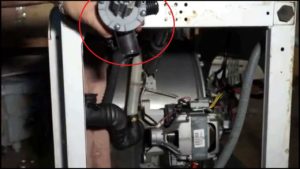
- disconnect the service hatch door from the body;
- Unscrew the drain filter and empty the drum;
- loosen the bolts holding the pump;
- disconnect the wiring and connected hoses from the device;
- turn the pump counterclockwise, pressing it deep;
- look under the washer through the bottom, feel for the pump and pull it out.
When disassembling Candy, follow safety precautions: disconnect the washing machine from communications and take care of personal protective equipment!
For greater convenience, Candy can be turned on its side. It is important that this is the side on which the powder receptacle is located - usually the left. This way you can look under the bottom and dismantle the pump faster. The removed pump must be placed on a dry surface and diagnostics of the device can begin.
Major pump cleaning
At home, DIY repairs regarding the pump are limited to cleaning it. As such, the pump does not get particularly dirty, and its impeller is often blocked due to hair and threads wrapped around the blade. In order for the part to spin again and the mechanism to work, it is necessary to remove all adhering debris. It's simple:
- Use a suitable screwdriver to unscrew the housing;
- divide the pump into two “halves”;
- we find the “head” with the impeller and remove all the debris from the blades.
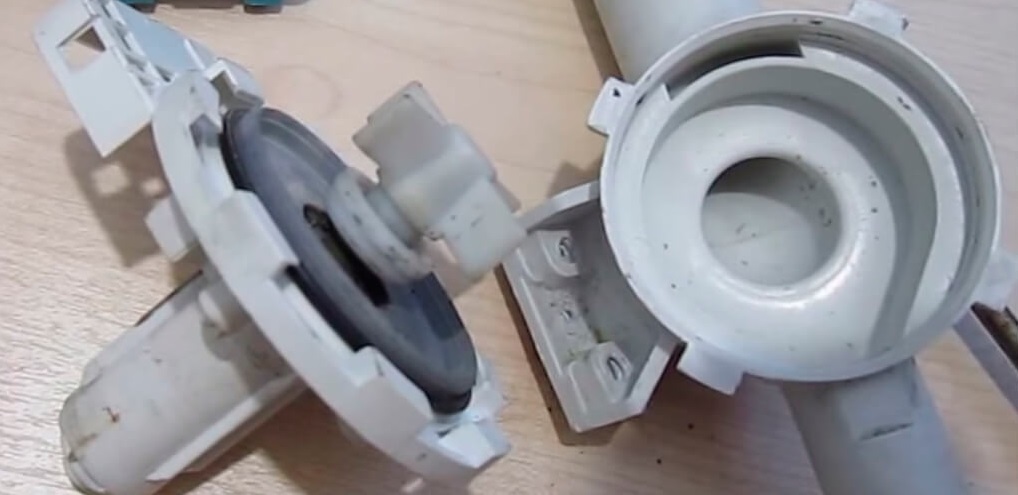
The impeller should rotate, but not fly off the axis. If the “wheel” falls off the rod, you will have to work in the opposite direction - tighten the fasteners. When tightening does not help, you need to change the part. Attempting to fix the blades with glue or electrical tape is useless and harmful.
It is recommended to immediately rinse the snail. After cleaning, the impeller is installed back on the pump, and it is fixed in place. Then we return the garbage filter to the machine and turn on the unit to the network and to the water supply. Checking the cleaned pump is mandatory - start the “idle” fast mode and evaluate the functionality of the drain.If water is pumped out of the drum into the sewer without any problems, then everything has been done correctly.
“Arming ourselves” with a multimeter
 To be on the safe side and not disassemble Candy again, it is advised not only to clean the pump, but also to immediately test it with a multimeter. It is enough to turn on the meter as an ohmmeter, connect the “clamps” to the contacts and evaluate the indicators. A properly functioning device will show a minimum of 150 Ohms, a maximum of 260. Other values will indicate a breakdown.
To be on the safe side and not disassemble Candy again, it is advised not only to clean the pump, but also to immediately test it with a multimeter. It is enough to turn on the meter as an ohmmeter, connect the “clamps” to the contacts and evaluate the indicators. A properly functioning device will show a minimum of 150 Ohms, a maximum of 260. Other values will indicate a breakdown.
If “O” appears on the display, then the drain does not work due to a short circuit in the system. A resistance of about 120 will signal a winding break. Repairing a faulty pump at home is difficult and unprofitable - it’s easier and cheaper to buy a new one.
It is not difficult to install a new pump with your own hands. You just need to choose the right replacement, based on the Candy serial number. The easiest and surest way is to take an old pump, take it to the store and find an analogue based on the sample. If cleaning the filter and replacing the pump did not help, then the control board is to blame. Diagnosing it at home is prohibited - it is better to contact a service center.
Interesting:
Reader comments
- Share your opinion - leave a comment
Categories
Washing machine repair


For buyers

For users

Dishwasher




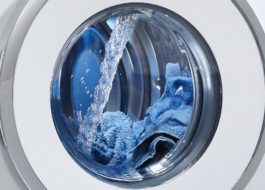

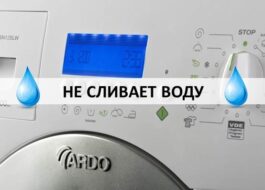










Add a comment